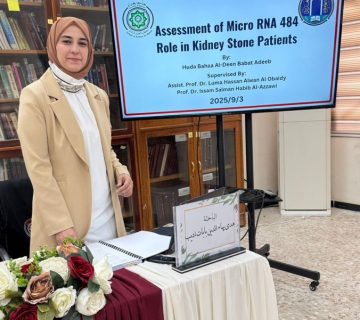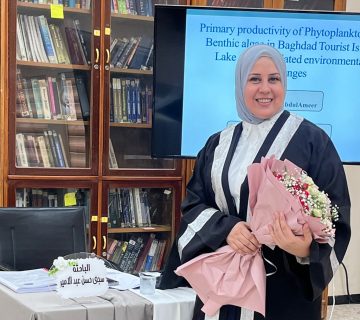College of Science for Women / University of Baghdad examined the dissertation entitled (Ecological monitoring and Environmental impact of PAHs pollution in Tigris River from
The dissertation aims to investigate the levels, sources and origins of polycyclic aromatic hydrocarbons (PAHs) in water, sediments and two species of Mollusca(Bellamya bengalensis and Pseudodontopsis euphrates) in Tigris River from Baghdad to Wasit Governorate, in addition to measuring the river’s physicochemical parameter. Five sites were chosen on Tigris River from Baghdad (Al-Daura) to AL-Kut (AL-Suwaira, AL-Aziziyah, AL-Zubaidi & Kut dam),
Gas chromatography (GC) was used to investigate the levels of PAHs in sediment, water and Mollusca after extraction.
The dissertation also included the evaluation of PAHs compounds, as the current study showed the presence of sixteen polycyclic aromatic hydrocarbons (PAHs) compounds, including: Naphthalene (Nap), Acenaphthylene (Acy), Acenaphthene (Ace), Fluorene (Flu), Phenanthrene (Phe), Anthracene (Ant), Fluoranthene (Fla), Pyrene (Pyr), Benzo(a)Anthracene (BaA), Crysene (Chr), Benzo(b)Fluoranthene (BbF), Benzo(k)Fluoranthene (BkF), Benzo(a)Pyrene (BaP), Indeno (123-cd)Pyrene (IcdP), Dibenzo(a,h)Anthracene (DahA) and Benzo(g,h,i)Pyrylene (BghiP) in water, sediment and Mollusca samples and the origin of polycyclic aromatic hydrocarbons in the Tigris River was pyrogenic (anthropogenic),
The most important recommendations which the study has come up with:
- It is necessary to minimize fuel and combustion near river water.
- Wastewater from homes, industries, and farms near the river should be treated before being released.
- find environmentally friendly methods of disposing of pollutants rather than burning or burying them underground, as these methods do not address the issue.
Final Grade: Excellence










